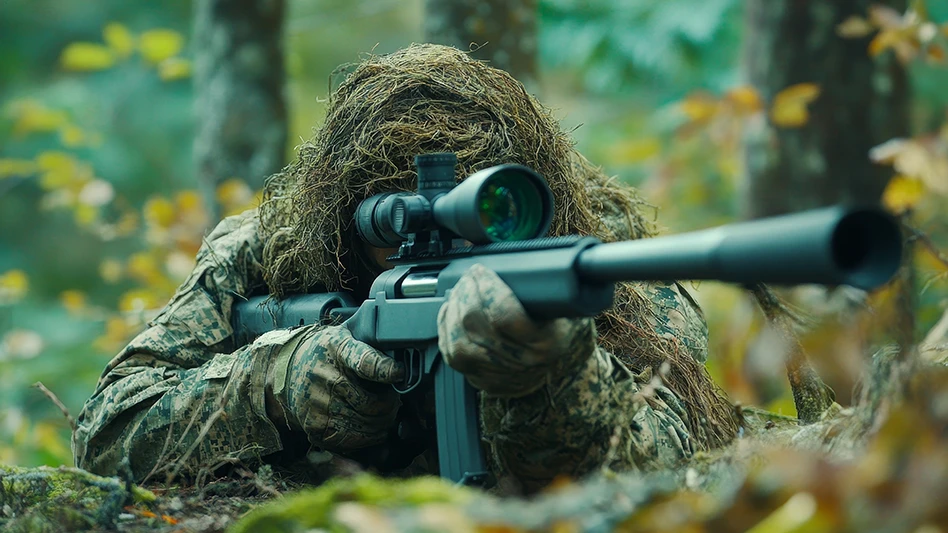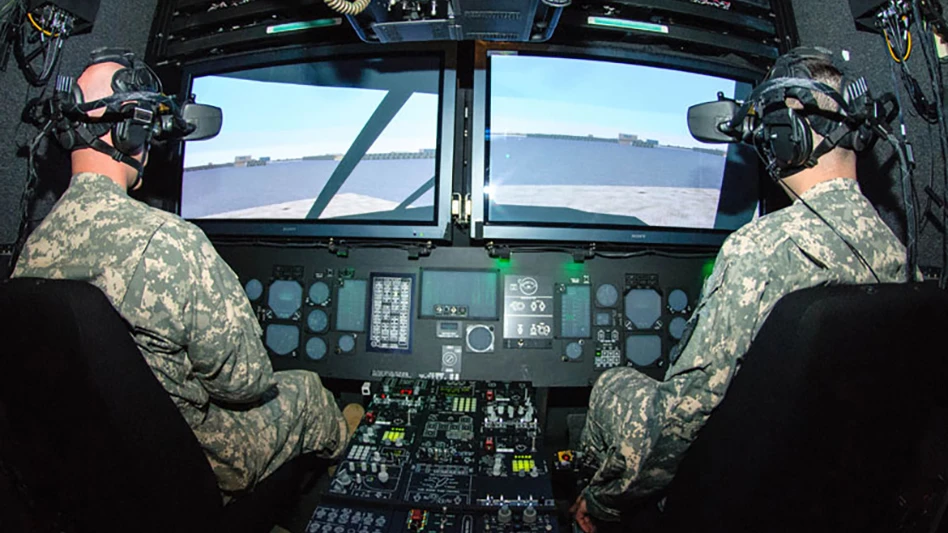
Adobe Stock #917946698/jechm

Conflicts continue in Ukraine and the Middle East while the United States stockpiles weapons as tensions escalate with China, so defense and munitions manufacturing will continue to be a priority as we turn the calendar to 2025. How much will be spent and what it will be spent on are still questions that will have to be answered in the New Year, but at Defense and Munitions we’ll forecast what to expect in 2025 in the U.S. and globally.
US defense budget
The proposed 2025 budget for the United States Department of Defense (DOD) totals $850 billion, 1.1% less than the amount anticipated for 2025 in the previous Future Years Defense Program (FYDP), a five-year plan the Department of Defense (DOD) prepares as part of its annual budget request) and 1.7% less than the amount appropriated by Congress for 2024. However, the DOD budget should climb to $866 billion (when adjusted for inflation) by 2029, a total increase of 1.9% from 2025. The Congressional Budget Office (CBO) projects the cost of the DOD’s plans would increase by 11% throughout 10 years following the FYDP period, reaching $965 billion in 2039, a 64% increase in operation and support, 32% in acquisition, and 4% in infrastructure.
- Ukraine Fighting continues between Russia and Ukraine as the U.S. helps stock the Ukrainian military with weapons to defend against advancing Russian troops. Since February 2022, the U.S. government has reportedly committed more than $66 billion in assistance for Ukraine, the vast majority going toward 155mm howitzer artillery shells. Jen Judson, Land Warfare Reporter for Defense News, reported in October the Army planned to spend $3.1 billion to ramp up production of 155mm shells in 2024 with a target of producing 100,000 artillery shells per month. The Army is now producing 40,000 shells a month with hopes of reaching 55,000 shells a month by the end of 2024 according to Army Secretary Christine Wormuth. Doug Bush, the Army’s acquisition chief, told Judson production of the 155mm shells will increase from one facility to four facilities in North America by 2025.
- Middle East According to the Watson Institute for International and Public Affairs at Brown University, the U.S. government has approved at least $17.9 billion in security assistance for Israeli military operations in Gaza since October 2023. That assistance climbs to at least $22.76 billion in military aid to Israel and related U.S. operations in the region including 57,000 artillery shells; 36,000 rounds of cannon ammunition; 20,000 M4A1 rifles; 13,981 anti-tank missiles; and 8,700 MK-82 500 lb bombs.
Global military budget
The world defense budget was estimated to be approximately $2.005 trillion in 2023 and is expected to reach approximately $2.547 trillion by 2028 at a compound annual growth rate (CAGR) of 4.90% according to MarketsandMarkets Research. Geopolitical tensions, regional conflicts, and addressing emerging challenges such as cyber warfare and terrorism are driving defense budget growth. Technological advancements and the race for military superiority have also fueled increased defense spending.
Emerging technologies
Additive Manufacturing Research reported the DOD spent $800 million on 3D printing/additive manufacturing (3DP/AM) in 2024, a 166% growth expected to maintain through the end of the decade, reaching $2.6 billion in 2030. Escalating and evolving global tension and security challenges position the 3DP/AM industry as crucial for defense and military entities to conceptualize, develop, and deploy critical assets and equipment quickly.
The Insight Partners report the loitering munitions market is projected to reach $2.02 billion by 2031, increasing from $1.01 billion in 2023 for a CAGR of 9.0%. The fixed-wing segment has dominated the loitering munition market and can be used for longer range applications than rotary-wing loitering munition as it has greater endurance, higher speed, and larger payload capacity. Fixed- and rotary-wing loitering munitions can be equipped with missiles or bombs to strike targets from a safe distance to reduce the risk of collateral damage. Both types provide a high degree of accuracy with the ability to precisely engage the target.
The unmanned surface vessel market is expected to more than double from $1.1 billion in 2024 to $2.5 billion by 2034 according to GlobalData. More than 40 countries will operate unmanned surface vessels (USVs) by 2034. The proliferation of unmanned systems in the global defense market continues to have a growing impact on the future of naval warfare. Interest in the wartime role of USVs has increased, especially since the beginning of the Russia-Ukraine conflict. The USV market is forecast to experience a CAGR of 6.7% between 2025 and 2029.
Military spending


Technavio forecasts the land-based defense equipment market to increase by $34.12 billion at a CAGR of 8.4% between 2023 and 2028. The land-based defense equipment market is witnessing significant advancements, driven by the integration of technology into military applications. One trend is the electrification of defense vehicles, including battle tanks and armored personnel carriers, to enhance their mobility and reduce fuel consumption. Another trend is increasing adoption of unmanned systems, such as drones and robots, for surveillance, reconnaissance, and combat missions.
Technavio also reports the ground-based aircraft and missile defense market is forecast to increase by $6.46 billion at a CAGR of 7.1% between 2024 and 2029. The market is experiencing significant growth due to the increasing demand for military supremacy and advanced military procurement. The development of new-generation air and missile defense systems is a major market driver, as these systems are essential for countering surface-to-air missiles, air-to-surface missiles, air-to-air missiles, and anti-ship missiles. The rising threat from unmanned aerial vehicles (UAVs) is also pushing nations to invest in advanced defense systems.
The global rocket and missile market is projected to increase from $62.50 billion in 2024 to $85.22 billion by 2029 at a CAGR of 6.4% according to MarketsandMarkets. The growth is driven by increasing defense programs with the objective of strengthening country security against threats. Due to ongoing conflicts and rising defense expenditures worldwide, there’s an increase in demand for missiles and rockets. Governments’ efforts to strengthen their military preparedness and capabilities also contribute to this market expansion. Businesses are spending on R&D and advancing in rocket and missile technologies to strengthen their position in the market.
The Insight Partners report the artillery systems market is projected to reach $20.98 billion by 2031 from $11.99 billion in 2023 at a CAGR of 7.2%. Rising deployment of self-propelled artillery systems is likely to bring in new trends in the market. Rising global military expenditure, increasing numbers of contracts for the supply of artillery systems, and rising deployment of self-propelled artillery systems by various armed forces worldwide are expected to drive the artillery. The introduction of smart weapons and smart ammunition, including precision-guided missiles, guided mortars, and guided artillery systems, is also likely to fuel growth.
The North Atlantic Treaty Organization (NATO) ammunition market is forecast to increase by $179.2 million at a CAGR of 4.5% by 2028 according to Technavio. The market is experiencing significant growth as countries seek to modernize and expand their military capabilities. Another trend influencing the market is the reduction in the weight of ammunition, which enhances military logistics, procurement, and agility. The increase of illicit ammunition manufacturers poses a significant challenge to market growth, as it undermines the quality and reliability of legitimate suppliers. Also, the increasing demand for precision-guided munitions and the integration of advanced technologies into ammunition systems are key trends shaping the market’s trajectory.
Firearms
The rifles market is forecast to increase $766.5 million at a CAGR of 3.5% between 2023 and 2028 according to Technavio. The market is witnessing significant growth due to increasing defense spending globally, leading to increased demand for advanced rifles from military and law enforcement agencies. The increasing demand for customized weapons is leading companies to invest in automation and advanced bullet loading technologies. The development of self-steering bullets and sniper accessories is enhancing the precision and effectiveness of rifle systems. The rise of terrorism and the subsequent need for advanced precision weapon systems has also increased focus on semi-automatic and automatic weapons.
The small arms market is projected to grow to $11.1 billion by 2027 at a CAGR of 4.5% according to MarketsAndMarkets. Rising investments in the development of new and advanced firearms and ammunition along with modernization of small arms are driving factors for market growth. Handguns such as pistols and revolvers along with rifles such as assault rifles, sniper rifles, shotguns, and machine guns are witnessing heavy demand in North America, Europe, and the Middle East. The increasing demand has led to application-specific and technologically advanced small arms. Manufacturers are developing and launching different types of firearms to attract more customers and generate revenue. Continuous research and development (R&D) is being carried out to develop small arms with enhanced precision, mobility, and lethality.
The small caliber ammunition market size is projected to reach $13.19 billion by 2031 from $6.76 billion in 2023 at a CAGR of 8.7% according to The Insight Partners. Adoption of new squad automatic rifles by military forces is likely to remain a key trend in the market. Armed forces are focusing on caliber sizes such as 7.62mm for attaining greater projectile ranges, as the existing calibers such as 5.56mm are becoming ineffective in piercing tougher armors. Small caliber ammunition segmented into 5.56mm, 7.62mm, 9mm, 12.7mm, 14.5mm, 45ACP, .338mm, .22LR, 223 REM, .308 Winchester, and others with the 9mm holding a larger market share in 2023. The end user is segmented into military, homeland security, and law enforcement agencies as the military held a larger market share in 2023. The market is segmented into pistols, rifles, and shot guns with pistols holding a larger market share in 2023.
SafeHome.org reports 5.5 million firearms were sold in the U.S. in the first four months of 2024 while 16.7 million firearms were sold in the U.S. in 2023, a 4% decline from 2022. Statista meanwhile reports since 2022, approximately 42% of American households own at least one firearm.
Conclusion
Congress may have slightly reduced the defense budget for the United States but conflicts continue for Ukraine and Israel so defense, firearms, and munitions manufacturers can expect to stay busy in 2025 and the coming years. Also, personal protection in the United States is gaining interest so civilian firearms sales will allow gun manufacturers to keep producing pistols, rifles, shotguns, and any other firearms, ammunition, and accessories customers might want.
Additive Manufacturing Research
https://www.additivemanufacturingresearch.com
Defense News
https://www.defensenews.com
GlobalData
https://www.globaldata.com
MarketsandMarkets
https://www.markets andmarkets.com
SafeHome.org
https://www.safehome.org
Technavio
https://www.technavio.com
The Insight Partners
https://www.the insightpartners.com
United States Department of Defense
https://www.defense.gov
Watson Institute for International and Public Affairs at Brown University
https://home.watson.brown.edu
Fact sheet on US security assistance to Ukraine Read the full COSTS OF WAR paper from the Watson Institute for International and Public Affairs at Brown University
https://media.defense.gov/2024/Dec/30/2003619433/-1/-1/1/Ukraine-Fact-Sheet-December-30-2024.PDF
Troy Wilt, Managing Director, CERATIZIT USA

The U.S. defense and munitions industry is experiencing unprecedented production demand – and that demand shows no signs of slowing. While this is encouraging for manufacturers, the persistent skilled labor shortage presents a significant challenge: how to meet increasing expectations with fewer people.
Currently, U.S. military forces remain in a state of readiness without engaging in heightened conflict. However, escalating wars and global tensions have driven the U.S. Department of Defense to supply critical resources to allies, significantly depleting domestic munitions inventories. Manufacturers – large and small – are being called upon to rapidly scale production of bombs, missiles, bullets, shells, and other armaments to replenish these supplies.
The shrinking workforce forces manufacturers to innovate. Many shop owners and project managers are re-evaluating their vendor relationships, seeking partners who deliver and understand the complexities of production. They need partners with technical expertise to optimize every step of the process: programming, engineering, testing, increasing speeds and feeds, and maximizing throughput.
At CERATIZIT, we’ve embraced this role. As demand grows, we have stepped in to provide customers with the technical resources, machining expertise, and print-to-part capabilities they need to keep pace. This trend is likely to persist. Even as workforce challenges are addressed, the introduction of new materials will require ongoing support and innovation.
The next generation of manufacturers will face unknown parameters and applications and will need strong partnerships to master them. At CERATIZIT, we are committed to supporting our customers – today and into the future – as they rise to meet these challenges.
CERATIZIT USA
https://www.ceratizit.com

Explore the January/February 2025 Issue
Check out more from this issue and find your next story to read.
Latest from Defense and Munitions
- #53 - Manufacturing Matters - 2024 Leaders in Manufacturing Roundtable
- Visual Components celebrates 25 years of simulation and programming software innovation
- Join us for insights on one of the hottest topics in manufacturing!
- Hive Systems Defense Solutions achieves C3PAO authorization
- Shield AI, L3Harris team for breakthrough in autonomy
- You can still register for March’s Manufacturing Lunch + Learn!
- Leonardo DRS receives $45 million U.S. Navy commitment to bolster US submarine industrial base
- Teledyne FLIR Defense wins $15 million contract for Black Hornet 4 Nano-Drones





